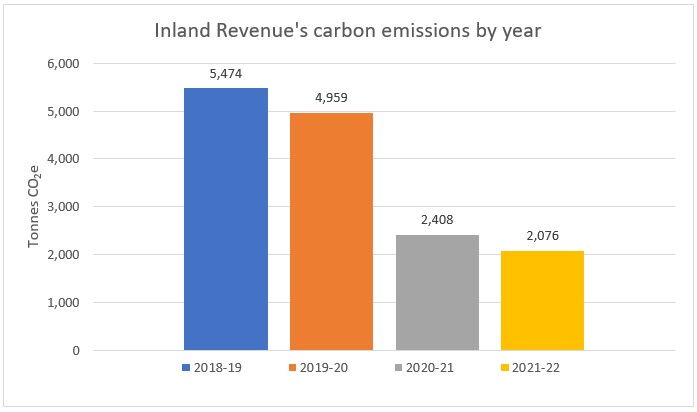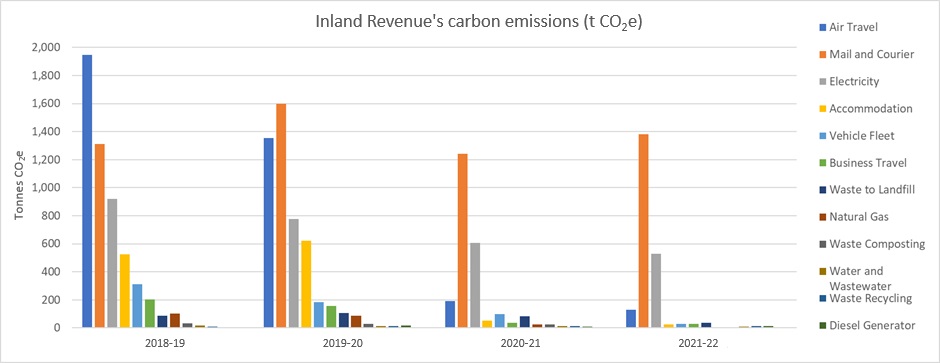Inland Revenue is committed to minimising our environmental footprint by managing the impact of our day-to-day work. We have a plan to reduce our carbon emissions.
We're one of 120 organisations taking part in the Carbon Neutral Government Programme (CNGP), which was established in November 2020 to combat climate change and achieve carbon neutrality by 2025.
Our efforts are currently focused on the requirements of the CNGP. These include:
- measuring and seeking external audit verification of our carbon emissions and developing an emissions reduction plan and reduction targets
- purchasing electric vehicles (EVs) and reducing and optimising our vehicle fleet
- seeking building energy efficiency assessments for the larger sites we occupy.
This year, we've been sourcing information to measure our carbon emissions and set a target for reductions. We set our emissions base year as 2018–19 as it was the most recent full year of Inland Revenue operating without COVID-19 impacts.

Our data and calculations have been independently verified against ISO#14064-1:2018 by Toitū Envirocare (Enviro-Mark Solutions Limited), a wholly-owned subsidiary of Manaaki Whenua Landcare Research.
In 2021–22, we emitted 2,076 tonnes of carbon dioxide equivalent (tCO2e), a 14% reduction on our previous year, and 62% lower than our 2018–19 base year).
The bulk of our 2021–22 emissions were generated by the freight associated with our mail, particularly international mail, followed by electricity used in our 28 offices (including temporary sites) and air travel.
International mail makes up just under 5% of all paper-based mail and accounts for 69% of mail freight emissions.
We expect air travel to continue to be much lower due to the office technology we now have in place, which enables our people to work remotely and virtually. However, travel remains essential for activities such as tax audits, partner and intermediary engagement, court attendances, attending specialist conferences and for our people leaders to connect with their remote teams.
The breakdown of our emissions by source across the 4 years is shown in the following graph.

COVID-19 restrictions and lockdowns have led to a significant reduction in all travel-related emissions from the fourth quarter of 2019–20. Also, we have reduced our property footprint through consolidating office accommodation in some locations and releasing floors in other sites. This has contributed to a downward trend in energy emissions.
The ongoing effects of the pandemic and the winter flu season have led to a further reduction from 2020–21 in all forms of domestic travel. Electricity has reduced because our people are working from home on some days and because of our reducing property footprint. However, some of the benefits of exiting buildings have been offset by our need to find temporary office space from July 2021. This is when we vacated our largest site, Asteron Centre in Te Whanganui a Tara Wellington, because it needs a seismic upgrade.
Under the Carbon Neutral Government Programme (CNGP), Inland Revenue must reduce gross emissions in line with the Paris Agreement to limit the global average temperate increases to no more than 1.5 degrees above pre-industrial levels. This means reducing our gross emissions by 21% by 2025 and 42% by 2030 from our 2018–19 base year.
We're aiming to better this - we're committed to emissions reductions of 43% by 2025 and 50% by 2030 from our base year.
We've identified 7 key initiatives to achieve our emission reduction targets.
- Transition to a fully electric vehicle (EV) fleet - we will replace the rest of our petrol-based fleet vehicles with EVs by 30 June 2024 and install EV chargers for all vehicles.
- Reduce the vehicle fleet size and explore other optimisation options - we will 'right size' our vehicle fleet and explore options to share vehicles with other agencies and use car/ride share services.
- Enhance the energy efficiency of buildings - we will carry out energy efficiency assessments at all of our sites over 2,000m2. We'll work with landlords to upgrade air-conditioning systems and lighting as required while also exploring the benefits and costs of converting to LED lighting in all sites.
- Minimise office waste - we're reviewing and enhancing waste management practices at all sites and we will implement better signage and consistent recycling and waste bins in kitchen and utility areas.
- Reduce postal freight emissions - we will explore options for reducing postal volumes further and ways of delivering mail overseas that produce lower emissions.
- Reduce taxi and rental car emissions - we will explore options to switch to electric taxis and electric and low-emission rental cars.
- Minimise the post COVID-19 growth in air travel - we will explore ways to minimise travel now that internal COVID-related restrictions have been removed.
In terms of our progress on initiatives in our emission reductions plan, our fleet has reduced by 63 vehicles since 2018, and 35% of our fleet is now electric.
We have been assessing the energy efficiency of 11 of our 21 sites where we occupy over 2,000m2. We're using the National Australian Built Environment Ratings System New Zealand (NABERSNZ) assessment programme to identify areas where our sites could be more energy efficient. To date, 9 of our properties have been rated and all are at the minimum 4 stars out of 6 or above. We're working with our landlords to upgrade the lighting and air conditioning systems at some sites where assessments highlighted a need.
We're also considering a range of options to minimise waste going to landfill.
Inland Revenue's current reporting accounts for the emissions of our core business activities. We will look at emissions that come from the cloud-based data centres we use and from staff commuting. If material, we will add them to our reporting next year.
We're also beginning work with our key suppliers to increase the quality of their emissions source information and consider ways to jointly reduce our environmental footprints.

